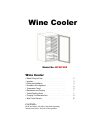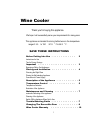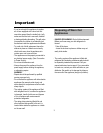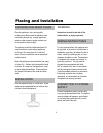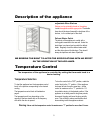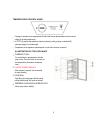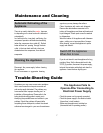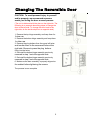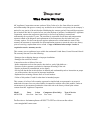The door is frequently opened or left open for If the discharge water outlet is clogged, or the
too long. defrost water drips over the channel, water will
The door is not properly closed (the door may leak from the appliance.
sag, the gasket may be polluted or damaged).
.
Clean the clogged outlet.
Perhaps you may have overloaded the appliance.
.
Manually defrost the increased ice layer ( see
The reason may be inadequate ventilation of the ice Formation on the Inner rear Wall ).
compressor (assure adequate air circulation).
Noise
Cooling in this appliance is made possible by
cooling the system using a compressor, which
will produce certain noise levels. How noisy
A
s long as the defrost water runs to the
the appliance is depends on where it is placed,
channel and through the outlet to the drain
how it is used and how old the appliance is.
pan on the compressor, automatic defrosting
.
During the operation of the compresso
r
of the appliance is assured.
the noise of the liquid is heard and when the
In case the ice formation on the inner back compressor is not operating, the refrigerant flow
wall is increased (1/8-1/5in.), ice should be is heard. This is a normal condition and it has
manually defrosted. no influence whatsoever on the lifetime of the
Set the thermostat knob to STOP ( 0 )
appliance.
position and leave the door open. Never
.
A
fter starting the appliance, the
use electric devices for defrosting and do operation of the compressor and the refrigerant
not scrape the ice or frost layer with sharp flow may be louder, which does not mean that
objects. something is wrong with the appliance and it has
no influence on the lifetime of the appliance.
A
fter defrosting is complete, turn the knob to Gradually the noise will reduce.
desired position and close the door. The
.
Sometimes unusual and loude
r
noise
cause of increased ice formation may be may be heard. This noise is often a
one of the following: consequence of inadequate installation.
the door does not seal well (clean the
_
The appliance must be level and installed on
gasket if it is contaminated, or replace it if a firm solid base/floor.
it is damaged);
_
The appliance should not touch the wall or
the door is frequently opened or left too kitchen units standing next to it.
long;
_
Check the accessories on the interior of the
the food stored in the appliance was warm; appliance, they should be placed correctly in
the food or dish is touching the inner back their positions; also check bottles, tins, and
wall. other vessels are not touching each other
causing rattling and/or vibrations.
8
Continuous Operation of the
Cooling System
Ice Formation on the
Inner Rear Wall
Water is Leaking From the
Appliance



